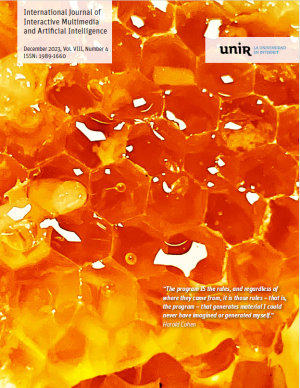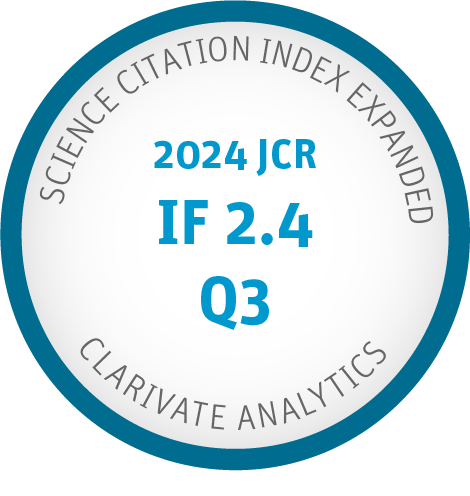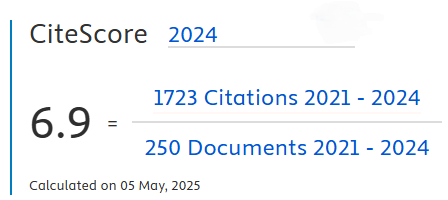Synthetic Aperture Radar Automatic Target Recognition Based on a Simple Attention Mechanism.
DOI:
https://doi.org/10.9781/ijimai.2023.02.004Keywords:
Attention Model, Convolutional Neural Network (CNN), Target Recognition, Synthetic Aperture RadarAbstract
A simple but effective channel attention module is proposed for Synthetic Aperture Radar (SAR) Automatic Target Recognition (ATR). The channel attention technique has shown recent success in improving Deep Convolutional Neural Networks (CNN). The resolution of SAR images does not surpass optical images thus information flow of SAR images becomes relatively poor when the network depth is raised blindly leading to a serious gradients explosion/vanishing. To resolve the issue of SAR image recognition efficiency and ambiguity trade-off, we proposed a simple Channel Attention module into the ResNet Architecture as our network backbone, which utilizes few parameters yet results in a performance gain. Our simple attention module, which follows the implementation of Efficient Channel Attention, shows that avoiding dimensionality reduction is essential for learning as well as an appropriate cross-channel interaction can preserve performance and decrease model complexity. We also explored the One Policy Learning Rate on the ResNet-50 architecture and compared it with the proposed attention based ResNet-50 architecture. A thorough analysis of the MSTAR Dataset demonstrates the efficacy of the suggested strategy over the most recent findings. With the Attention-based model and the One Policy Learning Rate-based architecture, we were able to obtain recognition rate of 100% and 99.8%, respectively.Downloads
References
E. M. Ampe et al., “Impact of Urban Land-Cover Classification on Groundwater Recharge Uncertainty,” IEEE Journal of Selected Topics in Applied Earth Observations and Remote Sensing, vol. 5, no. 6, pp. 1859– 1867, Dec. 2012, doi: 10.1109/jstars.2012.2206573.
E. P. W. Attema, G. Duchossois, and G. Kohlhammer, “ERS-1/2 SAR land applications: overview and main results,” IGARSS ’98. Sensing and Managing the Environment. 1998 IEEE International Geoscience and Remote Sensing. Symposium Proceedings. (Cat. No.98CH36174), 1998, doi: 10.1109/igarss.1998.703655.
P. Gamba and M. Aldrighi, “SAR Data Classification of Urban Areas by Means of Segmentation Techniques and Ancillary Optical Data,” IEEE Journal of Selected Topics in Applied Earth Observations and Remote Sensing, vol. 5, no. 4, pp. 1140–1148, Aug. 2012, doi: 10.1109/jstars.2012.2195774.
D.E. Dudgeon and R.T. Lacoss. “An overview of automatic target recognition,” Te Lincoln Laboratory Journal, vol. 6, no. 1, pp. 3–10, 1993.
Y. Cui, G. Zhou, J. Yang, and Y. Yamaguchi. “On the iterative censoring for target detection in SAR images,” IEEE Geoscience and Remote Sensing Letters, vol. 8, no. 4, pp. 641–645, 2011.
Z. Lin, K. Ji, M. Kang, X. Leng, and H. Zou. “Deep convolutional highway unit network for SAR target classification with limited labeled training data,” IEEE Geoscience and Remote Sensing Letters, vol. 14, no. 7, pp. 1091–1095, 2017.
Z. Huang, Z. Pan, and B. Lei. “Transfer learning with deep convolutional neural network for SAR target classification with limited labeled data,” Remote Sensing, vol. 9, no. 9, p. 907, 2017.
J. Ding, B. Chen, H. Liu, and M. Huang. “Convolutional neural network with data augmentation for SAR target recognition,” IEEE Geoscience and Remote Sensing Letters, vol. 13, no. 3, pp. 364–368, 2016.
Y. Bengio, P. Simard, and P. Frasconi. “Learning long-term dependencies with gradient descent are difficult,” IEEE Transactions on Neural Networks and Learning Systems, vol. 5, no. 2, pp. 157–166, 1994.
X. Glorot and Y. Bengio. “Understanding the difficulty of training deep feedforward neural networks,” Journal of Machine Learning Research, vol. 9, pp. 249–256, 2010.
H. Kaiming, X. Zhang, S. Ren, and J. Sun. “Deep residual learning for image recognition,” in Proceedings of the IEEE Conference on Computer Vision and Pattern Recognition (CVPR’ 16), pp. 770– 778, 2015.
L.M. Kaplan “Analysis of multiplicative speckle models for template-based SAR ATR,” IEEE Transactions on Aerospace and Electronic Systems, vol. 37, no. 4, pp. 1424–1432, 2001.
Z. Hussein Arif et al., “Adaptive Deep Learning Detection Model for Multi-Foggy Images,” International Journal of Interactive Multimedia and Artificial Intelligence, vol. 7, no. 7, pp. 26-37, 2022, doi: 10.9781/ijimai.2022.11.008.
H. Ma, J. C. Chan, T. K. Saha and C. Ekanayake. “Pattern recognition techniques and their applications for automatic classification of artificial partial discharge sources,” IEEE Transactions on Dielectrics and Electrical Insulation, vol. 20, no. 2, pp. 468–478, 2013.
G. J. Owirka, S. M. Verbout and L. M. Novak. “Template-based SAR ATR performance using different image enhancement techniques,” vol. 3721 of Proceedings of SPlE, pp. 302–319, April 1999.
Y. Kuno, K. Ikeuchi and T. Kanade. “Model-based vision by cooperative processing of evidence and hypotheses using configuration spaces,” vol. 938 of Proceedings of SPlE, 444 pages, Orlando, Fl, USA, 1988.
S. Singha, J. T. Bellerbyand O. Trieschmann. “Detection and classification of oil spill and look-alike spots from SAR imagery using an artificial neural network,” in Proceedings of the 2012 32nd IEEE International Geoscience and Remote Sensing Symposium, IGARSS 2012, pp. 5630–5633, Germany, July 2012.
C. Yuan and D. Casasent. “MSTAR 10-Class classification and confuser and clutter rejection using SVRDM,” in Proceedings of the Defense and Security Symposium XVII, pp. 624501–624513.
J. Zhao, W. Guo, S. Cui, Z. Zhang and W. Yu. “Convolutional neural network for SAR image classification at the patch level,” in Proceedings of the 36th IEEE International Geoscience and Remote Sensing Symposium, IGARSS 2016, pp. 945–948, July 2016.
X. X. Zhu, D. Tuia, L. Mou, G. S. Xia, L. Zhang, F. Xu and F. Fraundorfer. “Deep learning in remote sensing: a comprehensive review and list of resources,” IEEE Geoscience and Remote Sensing Magazine, vol. 5, no. 4, pp. 8–36, 2017.
M. Kang, K. Ji, X. Leng, X. Xing, and H. Zou “Synthetic aperture radar target recognition with feature fusion based on a stacked autoencoder,” Sensors, vol. 17, no. 1, p. 192, 2017.
D. A. E. Morgan. “Deep convolutional neural networks for ATR from SAR imagery,” in Proceedings of the SPIE, pp. 1–13, Baltimore, MD, USA, July 2015.
S. Chen, H. Wang, F. Xu and Y. Q. Jin. “Target classification using the deep convolutional networks for SAR images,” IEEE Transactions on Geoscience and Remote Sensing, vol. 47, no. 6, pp. 1685–1697, 2016.
X. Li, C. Li, P. Wang, Z. Men and H. Xu. SAR ATR based on dividing CNN into CAE and SNN. 5th Asia Pacific Conference on Synthetic Aperture Radar (APSAR), Singapore, 2015:676–679.
T. Zhuangzhuang, Z. Ronghui, H. Jiemin and Z. Jun. "SAR ATR Based on Convolutional Neural Network," Journal of Radars, vol. 5, no. 3, pp. 320–325, 2016.
C. Szegedy, W. Liu, Y. Jia, P. Sermanet, S. Reed, D. Anguelov, D. Erhan, V. Vanhoucke and A. Rabinovich. “Going deeper with convolutions,” in Proceedings of the IEEE Conference on Computer Vision and Pattern Recognition (CVPR’ 15), pp. 1–9, IEEE, Boston, Mass, USA, June 2015.
C. Szegedy, V. Vanhoucke, S. Ioffe, J. Shlens and Z. Wojna. “Rethinking the inception architecture for computer vision,” in Proceedings of the 2016 IEEE Conference on Computer Vision and Pattern Recognition, CVPR 2016, pp. 2818–2826, July 2016.
F. Chollet, “Xception: deep learning with depthwise separable convolutions,” in Proceedings of the 30th IEEE Conference on Computer Vision and Pattern Recognition, pp. 1800–1807, 2016.
V. Mnih, N. Heess, A. Graves and K. Kavukcuoglu. Recurrent Models of visual attention. In Proceedings of the Neural Information Processing Systems (NIPS), Montreal, QC, Canada, 13 December 2014; pp. 2204– 2212.
P. Wu, Z. Cui, Z. Gan and F. Liu. "Residual group channel and space attention network for hyperspectral image classification," Remote Sensing, vol. 12, no. 12, pp. 2035, 2020.
S. Woo, J. Park, J.Y. Lee and I. S. Kweon. CBAM: Convolutional block attention module. In Proceedings of the European Conference on Computer Vision (ECCV), Munich, Germany, 8–14 September 2018; pp. 3–19.
X. Cheng, X. Li, J. Yang and Y. Tai. SESR: Single image super-resolution with a recursive squeeze and excitation networks. In 2018 24th International Conference on Pattern Recognition (ICPR) (pp. 147-152). IEEE.
D.-Q. Zhang, “clcNet: Improving the Efficiency of Convolutional Neural Network Using Channel Local Convolutions,” 2018 IEEE/CVF Conference on Computer Vision and Pattern Recognition, Jun. 2018, doi: 10.1109/cvpr.2018.00825.
H. Gao, Z. Wang, L. Cai, and S. Ji, “ChannelNets: Compact and Efficient Convolutional Neural Networks via Channel-Wise Convolutions,” IEEE Transactions on Pattern Analysis and Machine Intelligence, vol. 43, no. 8, pp. 2570-2581, 2021, doi: 10.1109/TPAMI.2020.2975796.
Q. Wang, B. Wu, P. Zhu, P. Li, W. Zuo, and Q. Hu, “ECA-Net: Efficient Channel Attention for Deep Convolutional Neural Networks,” 2020 IEEE/CVF Conference on Computer Vision and Pattern Recognition (CVPR), Jun. 2020, doi: 10.1109/cvpr42600.2020.01155.
L. N. Smith. Cyclical Learning Rates for Training Neural Networks. Proceedings - 2017 IEEE Winter Conference on Applications of Computer Vision, WACV 2017 pages 464 -472.
J. Hu, L. Shen, and G. Sun, “Squeeze-and-Excitation Networks,” 2018 IEEE/CVF Conference on Computer Vision and Pattern Recognition, Jun. 2018, doi: 10.1109/cvpr.2018.00745.
J. Hu, L. Shen, S. Albanie, G. Sun, and A. Vedaldi Gather-excite: Exploiting feature context in convolutional neural networks. In NeurIPS, 2018.
S. Woo, J. Park, J.-Y. Lee, and I. S. Kweon, “CBAM: Convolutional Block Attention Module,” Lecture Notes in Computer Science, pp. 3–19, 2018, doi: 10.1007/978-3-030-01234-2_1.
J. Fu et al., “Dual Attention Network for Scene Segmentation,” 2019 IEEE/ CVF Conference on Computer Vision and Pattern Recognition (CVPR), Jun. 2019, doi: 10.1109/cvpr.2019.00326.
E. R. Keydel, S. W. Lee and J. T. Moore, “MSTAR extended operating conditions: a tutorial,” in Proceedings of the Algorithms for Synthetic Aperture Radar Imagery III, vol. 2527, pp. 228–242, April 1996.
K. P. Murphy, “Machine learning: a probabilistic perspective,” MIT, 2012.
H. Furukawa. Deep learning for target classification from SAR imagery: Data augmentation and translation invariance. arXiv preprint arXiv:1708.07920. 2017 Aug 26.
J. A. O’Sullivan, M.D DeVore, V. Kedia and M.I Miller, “SAR ATR performance using a conditionally Gaussian model,” IEEE Transactions on Aerospace and Electronic Systems, vol. 37, no. 1, pp. 91-108, 2001.
U. Srinivas, V. Monga and G. R Raghu, “SAR automatic target recognition using discriminative graphical models,” IEEE transactions on aerospace and electronic systems, vol. 50, no. 1, pp. 591-606, 2014.
G. Dong, N. Wang, and G. Kuang. “Sparse representation of monogenic signal: with application to target recognition in SAR images,” IEEE Signal Processing Letters, vol. 21, no. 8, pp. 952– 956, 2014.
G. Dong, G. Kuang, N. Wang, L. Zhao and J. Lu “SAR target recognition via sparse joint representation of a monogenic signal,” IEEE Journal of Selected Topics in Applied Earth Observations and Remote Sensing, vol. 8, no. 7, pp. 3316–3328, 2015.
I. M. Gorovyi and D. S. Sharapov. Efficient object classification and recognition in SAR imagery. In 2017 18th International Radar Symposium (IRS) 2017 Jun 28 (pp. 1-7). IEEE.
D. Malmgren-Hansen, A. Kusk, J. Dall, A. A. Nielsen, R. Engholm and H. Skriver, “Improving SAR automatic target recognition models with transfer learning from simulated data,” IEEE Geoscience and remote sensing Letters, vol. 14, no. 9, pp. 1484-8, 2017.
M. Chang and X. You, “Target recognition in SAR images based on information-decoupled representation,” Remote Sensing, vol. 10, no. 1, pp. 138, 2018.
H. Furukawa. Deep learning for end-to-end automatic target recognition from synthetic aperture radar imagery. arXiv preprint arXiv:1801.08558. 2018 Jan 25.
Y. Wang, Y. Zhang, H. Qu and Q. Tian. Target detection and recognition based on convolutional neural network for SAR image. In 2018 11th International Congress on Image and Signal Processing, BioMedical Engineering and Informatics (CISP-BMEI) 2018 Oct 13 (pp. 1-5). IEEE.
F. Gao, T. Huang, J. Sun, J. Wang, A. Hussain and E. Yang, “A new SAR image target recognition algorithm based on an improved deep convolutional neural network,” Cognitive Computation, vol. 11, no. 6, pp. 809-24, 2019.
G. Dong and J. Chanussot. Target Recognition in SAR Image via Keypointbased Local Descriptor—Foundation. Preprints 2018, 2018050116 (DOI: 10.20944/preprints201805.0116.v1).
A. Zhang, X. Yang, L. Jia, J. Ai, and Z. Dong, “SAR image classification using adaptive neighborhood-based convolutional neural network,” European Journal of Remote Sensing, vol. 52, no. 1, pp. 178–193, Jan. 2019, doi: 10.1080/22797254.2019.1579616.
Y. Xie, W. Dai, Z. Hu, Y. Liu, C. Li, and X. Pu, “A Novel Convolutional Neural Network Architecture for SAR Target Recognition,” Journal of Sensors, vol. 2019, pp. 1–9, May 2019, doi: 10.1155/2019/1246548.
F. Xinyan and Z. Weigang, “Research on SAR Image Target Recognition Based on Convolutional Neural Network,” Journal of Physics: Conference Series, vol. 1213, no. 4, p. 042019, Jun. 2019, doi: 10.1088/1742-6596/1213/4/042019.
G. Dong, H. Liu, G. Kuang, and J. Chanussot, “Target recognition in SAR images via sparse representation in the frequency domain,” Pattern Recognition, vol. 96, p. 106972, Dec. 2019, doi: 10.1016/j.patcog.2019.106972.
T.-D. Wu, Y. Yen, J. H. Wang, R. J. Huang, H.-W. Lee, and H.-F. Wang, “Automatic Target Recognition in SAR Images Based on a Combination of CNN and SVM,” 2020 International Workshop on Electromagnetics: Applications and Student Innovation Competition (iWEM), Aug. 2020, doi: 10.1109/iwem49354.2020.9237422.
K. Wang and G. Zhang, “SAR Target Recognition via Meta-Learning and Amortized Variational Inference,” Sensors, vol. 20, no. 20, p. 5966, Oct. 2020, doi: 10.3390/s20205966.
G. Liu, H. Kang, Q. Wang, Y. Tian, and B. Wan, “Contourlet-CNN for SAR Image Despeckling,” Remote Sensing, vol. 13, no. 4, p. 764, Feb. 2021, doi: 10.3390/rs13040764.
X. Miao and Y. Liu, “Target Recognition of SAR Images Based on Azimuthal Constraint Reconstruction,” Scientific Programming, vol. 2021, pp. 1–10, Apr. 2021, doi: 10.1155/2021/9974723.
Downloads
Published
-
Abstract157
-
PDF46









